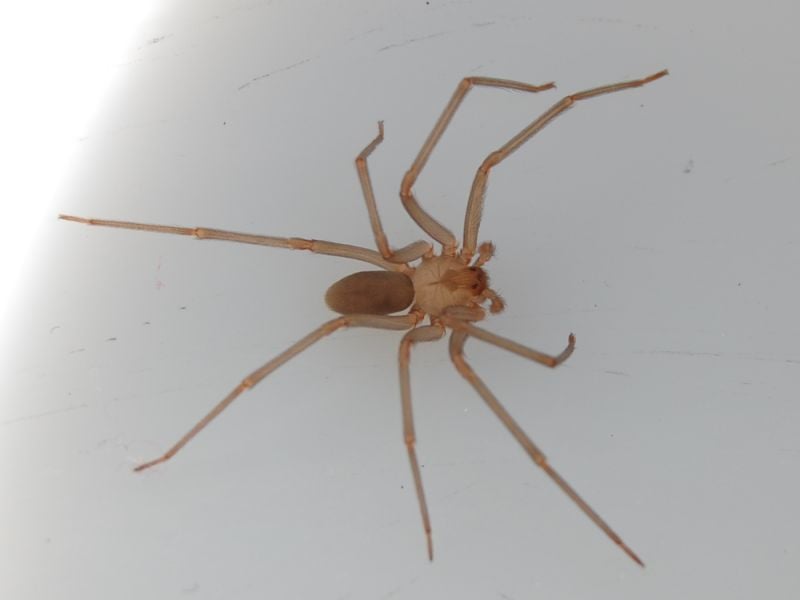What is a brown recluse spider?
Home » Blog » What is a brown recluse spider?
A brown recluse spider is a very common, venomous spider that can be found all over the United States. These spiders build their webs close to the ground, and are notorious for their aggressive behavior. Brown recluse spiders are not aggressive towards people unless they are threatened or annoyed. If you have a brown recluse spider bite, you may experience some pain and a small amount of swelling. In very rare cases, a brown recluse spider bites can result in serious health problems, including death If you are concerned about the presence of brown recluse spiders in your home, you can take several steps to prevent them from coming into your house. You can purchase spider traps that will capture these spiders, or you can use a vacuum cleaner with the hose attachment to remove their webs. For anyone that is unaware, a brown recluse bite is one of the most venomous spiders in the United States. If you are bitten by one, you could potentially experience severe pain, paralysis, and even death.

Types of Brown Recluse Spiders
As a result, it is important to know how to identify and avoid these spiders if you live in an area where they are common. In this article, we will discuss how to identify a brown recluse spider, as well as some tips on how to protect yourself from them if you do find them in your home. First and foremost, you will need to be able to recognize a brown recluse spider. They are typically about the size of a stamp, and have a yellow-brown body with a black stripe running down the back. They also have distinctive chevrons on their legs. If you do find a brown recluse spider in your home, the best strategy is to remain calm and take note of the symptoms of a brown recluse bite. If you are experiencing any of the following symptoms, you should seek medical help immediately.
Severe pain
Paralysis
Severe drooping of the eyelid
Brown recluse spiders are known to grow quite fast, so if you find one in your home, it is important to remove it as fast as possible. You can do this by either shaking it loose or picking it up and putting it in a jar full of fresh water. Make sure to label the jar so you know what spider it is! If you are bitten by a brown recluse spider, the best thing to do is to clean the wound as best as possible with soap and water. Apply pressure to the wound for 15 minutes until the bleeding stops. Then, take antibiotics if you are concerned about the wound becoming infected. Finally, apply a bandage to the wound and wait for it to dry. If you do find a brown recluse spider in your home, there is no need to be scared. Just take precautions to remove the spider and clean the wound as quickly as possible. If you are ever bitten by a brown recluse spider, be sure to seek medical help. The Brown Recluse Spider is an arachnid that is native to North America. It is known to cause a lot of pain, and in some cases, even death, due to the poison it produces. When identifying a Brown Recluse Spider, the most important thing to look for is the violin shape on its back. This shape is used to help the spider navigate its environment. The Brown Recluse Spider is not aggressive by nature, but if you are bitten by one, it is important to get medical help as soon as possible. If left untreated, the brown recluse venom from a Brown Recluse Spider can create serious damage to the victim’s body.
Brown Recluse Spider Infestation
Because of their secretive nature, brown recluse spiders can be difficult to eliminate. Almost any dark brown, unattended area can be used as a harbor. Many of these places are found within buildings. Professionals are best to treat this condition (and any potential health risk). You need to inspect the area where they hide with a flashlight. Crevices, corners and wall-floor junctions are common hiding spots, especially behind clutter or stored items. Reduced clutter makes it easier for spiders to hide, and improves the effectiveness of treatment. Brown recluse spiders can also be found behind walls and in the spaces between concrete block foundations. Infested crawl spaces, garages, basements, and attics, spider eggs, shed skins, and egg sacs can be found along joists sills and beams as well as under rolled insulation. They can be found in living spaces, including behind or beneath beds, furniture, closets, clothing and shoes, as well as under and underneath clothes, shoes, and other stored items. To avoid getting bitten, long sleeves and gloves are recommended when sorting through boxes and materials. Brown recluse spiders can also be found above suspended ceilings, behind baseboards, woodwork, and in ducts and registers. The spiders can be found outdoors in sheds, barns, woodpiles and under any ground covering. Shutters are often used to keep them out. You can reduce migration indoors by moving debris, firewood, and other building materials away from foundations. These pests can be kept out by sealing cracks and holes in exterior walls. Brown recluse spiders are attracted to gaps between doors, vents, and utility penetrations. They also like to enter buildings from the bottom edge, where siding meets the sides, and where waves meet soffits. The northern regions of the range have fewer brown recluse spiders. Use glue traps – A great way to search for brown recluses is to use flat sticky cards, also known as glue traps. The traps are often used to capture mice or cockroaches. They can be bought online, at hardware, grocery and farm supply stores, or purchased at a local hardware store. Flat glue traps work best for spider capture. They look like pieces of thin sticky cardboard with no raised edges. Use more glue traps to catch spiders. Using dozens of them throughout your home will show you where they are most active. Because spiders are known to be attracted to these areas, traps should not be placed along walls or baseboards. The glue traps are useful in detecting spiders and can be used to capture and kill large quantities of them, particularly the males. They are more likely than female brown recluse to wander into areas where they are accidentally bit. The number of spiders captured in traps can help you gauge the effectiveness of your eradication efforts. Before applying insecticides, glue traps must be set up. Some products can cause spiders to become active and wander into the traps. Insecticides are required for brown recluse spider removal. The adult brown recluse spiders that are females are more likely to be caught in glue traps than the male brown recluse spiders. You should spray insecticides into cracks and other places where brown recluse spiders may be hiding. Try to get as many of them as possible. You can use liquid, aerosol and dust formulations. Dust insecticides can be used to treat cracks in crawl spaces, basements, crawl spaces and attics. Dusts are also effective in treating cracks under insulation, behind concrete block foundations and behind outlet plates and light switches to repel spiders that travel along attic wires. Cimexa(r), Drione (r) (silica gel), Tri-Die (r) (cyfluthrin), Tempo (r) (cyfluthrin) and DeltaDust (r) are all effective dust insecticides. Dust should be applied as a fine dust that is barely visible to the naked eyes. Powdery accumulations are something spiders and other pests avoid much like we avoid walking in snow drifts. A ‘bellows hand duster’ is the best way to apply a small amount. It can be purchased in hardware stores and online. You can spray insecticides into places that spiders are known to frequent, such as harborages. Cyfluthrin and other effective ingredients such as deltamethrin (bifenthrin), cyfluthrin (cyfluthrin), lambda Cyhalothrin, and bifenthrin are all found in insecticides that are used to control cockroaches and other crawling insects. Sprays can be used outdoors, including behind shutters, at the foundations and along siding edges. These pesticide foggers also known as bug bombs are not effective against spiders and should be used only when otherwise inaccessible areas are being treated. If you’re like most homeowners, you’re always on the lookout for ways to keep your home pest-free. And with so many options available, it can be hard to know which approach to take. But don’t worry, there’s a pest control solution for everyone. Green Wave Pest Solutions has specialized in repelling and rid homes of pests for over 20 years. We have a wide range of products and services to choose from, so you can find the right solution for your needs. We offer a wide range of pest control solutions, including:
Pest Control Services
Rodent Control
Spider Control
Cockroach Control
We also offer a wide range of pest control services, including:
Pest Control Plans
Pest Control Services
Pre-Purchase Inspection for Pest Control
Pest Control Services for Commercial Buildings
Pest Control Services for Homes
So no matter what type of pest you’re dealing with, Green Wave Pest Solutions has the perfect solution for you. Ready to take the first step and get rid of those pests for good? Call us today!



